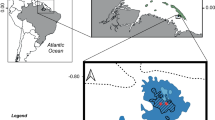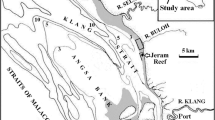Abstract
A survey of Kenya's shallow water (<2 m) coral reef-associated prosobranch fauna was undertaken to determine patterns of distribution, density, diversity and species richness, and the possible role of other reef fauna and human utilization on these patterns. The sample assemblage of 135 species from 25 families is similar to other Indian Ocean regions with no apparent endemism or subregional faunal affinities. Species richness, determined by species-individual relationships, has been reduced by approximately 45% since the Pleistocene. Northern Kenya, typified by small coral islands experiencing river and estuarine discharges had low densities and species richness and high species variability. This is attributable to the interrelated factors of river discharge, small reefs and reduced predator refuge. Southern Kenya's more expansive fringing reef has a denser and richer fauna but appears less species rich than Tanzania. Variation within reefs suggests similarities in diversity between reef lagoons, flats and edges, but lagoons had lower densities than reef flat or edge sites. This is attributable to greater predation rates within lagoons. Species composition between reef locations was variable but differed for comparisons between reef lagoons and reef flats. The population densities of thirty commercially collected species were compared between shelled and unshelled reefs. Only two commercial strombids, Lambis truncata and L. chiragra, had lower densities within shelled compared to unshelled reefs. Within six southern Kenvan reef lagoons, total gastropod densities were negatively correlated with the Balistidae (triggerfish) and total fish densities and positively with sea urchin densities. The removal of balistids through fishing appears to lead to co-occurring population increases in gastropod and sea urchin populations which, in most instances, appears to negate the effect of shell collecting.
Similar content being viewed by others
References
Abbott RT, Dance SP (1986) Compendium of seashells. American Malacologist, Melbourne, Fla
Brakel WH (1982) Tidal patterns on the East African coast and their implications for the littoral biota. Proc Symp Coastal Mar Envir Red Sea, Gulf Aden Trop West Indian Ocean 2:403–418
Bray JR, Curtis JT (1957) An ordination of the upland forest communities of southern Wisconsin. Ecol Monogr 27:325–349
Catterall CP, Poiner IR (1987) The potential impact of human gathering on shellfish populations, with reference to some NE Australian intertidal flats. Oikos 50:114–122
Connell JH (1972) Community interactions on marine rocky intertidal shores. Ann Rev Ecol Syst 31:169–192
Crame AJ (1986) Late Pleistocene molluscan assemblages from the coral reefs of the Kenyan coast. Coral Reefs 4:183–196
Dance SP (1974) The encyclopedia of shells. Blanford Press, London
Endean R (1973) Population explosions of Acanthaster planci and associated destruction of hermatypic corals in the Indo-West Pacific region. Biol Geol Coral Reefs 3:389–438
Evans SM, Knowles G, Pye-Smith C, Scott R (1977) Conserving shells in Kenya. Oryx 13:480–485
Hamilton HGH, Brakel WH (1984) Structure and coral fauna of East African reefs. Bull Mar Sci 34:248–266
Khamala CPM (1971) Ecology of Echinometra mathaei (Echinoidea: Echinodermata) at Diani Beach, Kenya. Mar Biol 2:167–172
Kenya Tide Table (1987) Tide tables for East African ports. Rodwell, Mombasa, Kenya
Kohn AJ (1968) Microhabitats, abundance and food of Conus on atoll reefs in the Maldive and Chagos Islands. Ecology 49:1046–1062
Knowles G (1970) Shell-collecting in Kenya. Report of the University of Newcastle-upon-Tyne Exploration Society's Expedition to Kenya. University of Newcastle-upon-Tyne, New Castle-upon-Tyne
Leviten PJ, Kohn AJ (1980) Microhabitat resource use, activity patterns, and episodic catastrophe: conus on tropical intertidal reef rock benches. Ecol Monogr 50:55–75
MacArthur RH, Wilson EO (1967) The theory of island biogeography. Princeton University Press, Princeton, NJ
McClanahan TR (1988a) Seasonality in East Africa's coastal waters. Mar Ecol Prog Ser 44:191–199
McClanahan TR (1988b) Coexistence in a sea urchin guild and its implications to coral reef diversity and degradation. Oecologia Berlin 77:210–218
McClanahan TR (1989) Kenyan coral reef-associated gastropod fauna: a comparison between protected and unprotected reefs. Mar Ecol Prog Ser 53:11–20
McClanahan TR, Muthiga NA (1988) Changes in Kenyan coral reef community structure and function due to exploitation. Hydrobiologia 166:269–276
McClanahan TR, Shafir SH (in press) Causes and consequences of sea urchin abundance and diversity in Kenyan coral reef lagoons. Oecologia Berlin
McClanahan TR, Muthiga NA (1989) Patterns of predation on a sea urchin, Echinometra mathaei (de Blainville), on Kenyan coral reefs. J Exp Mar Biol Ecol 126:77–94
NEHSS (1984) Kwale district assessment report. Ministry of Environment and Natural Resources, Nairobi, Kenya
Oliver APH (1975) The shells of the world, Country Life Books, Middlese, England
Reichelt RE (1982) Space: A non-limiting resource in the niches of some abundant coral reef gastropods. Coral Reefs 1:3–11
Richards D (1984) South African shells: a collectors guide. Struik, Cape Town, South Africa
Simpson EH (1949) Measurements of diversity. Nature 163:688
Sorensen T (1948) A method of establishing groups of equal amplitude in plant society based on similarity of species content. K Danske Vidensk Selsk 5:1–34
Spry JF (1968) The seashells of Dar es Salaam: 1 gastropods. Tanzania Society, Dar es Salaam, Tanzania
Taylor JD (1971) Reef associated molluscan assemblages in the western Indian Ocean. Symp Zool Soc London 28:501–534
Villanoy CL, Juinio AR, Meñez LA (1988) Fishing mortality rates of giant clams (Family Tridacnidae) from the Sulu Archipelago and Southern Palawan, Philippines. Coral Reefs 7:1–5
Wells SM (1981) International trade in ornamental corals and shells. Proc 4th Int Coral Reef Symp 1:323–330
Wells SM, Pyle RM, Collins NM (1983) The IUCN red data book. IUCN, Gland, Switzerland
Yaninek JS (1978) A comparitive survey of reef-associated gastropods at Maziwi Island, Tanzania. J E A Nat Hist Soc Nat Mus 31:1–16
Author information
Authors and Affiliations
Rights and permissions
About this article
Cite this article
McClanahan, T.R. Kenyan coral reef-associated gastropod assemblages: distribution and diversity patterns. Coral Reefs 9, 63–74 (1990). https://doi.org/10.1007/BF00368801
Accepted:
Issue Date:
DOI: https://doi.org/10.1007/BF00368801




